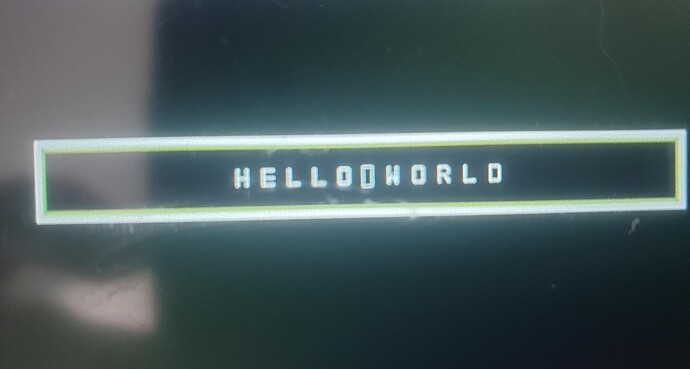Description
I’m trying to lay a button on top of an already displayed image om am LCD-display but the button has a white outline and is smaller than the desired size (the outline has the correct size). In the flush-Callback the coordinates in area differ from the defined button size and position (macros at the beginning of the code snippet). The background image was not drawn with LVGL but is an image in the external RAM read out by the LTDC-peripheral of the STM32.
What MCU/Processor/Board and compiler are you using?
STM32F439 witth STM32CubeIDE
What LVGL version are you using?
8.3.8
What do you want to achieve?
Draw a button to an already displayed image without it having a white outline (the green border is desired)
What have you tried so far?
set outline to 0, set desired button size, set desired button position, align to top left (doesn’t change the position of the button inside the outline), different background opacities and colors
Code to reproduce
/* Size and position of button in pixels */
#define DISP_WIDTH 1920
#define DISP_HEIGHT 1200
#define BOOTBUTTON_WIDTH 510
#define BOOTBUTTON_HEIGHT 53
#define BOOTBUTTON_LEFT_X0 246
#define BOOTBUTTON_LEFT_Y0 650
static lv_color_t __attribute__((__section__(".lvgldrawbuffsection1"))) drawBuffer[1300480]; /* in extrnal RAM */
static lv_disp_drv_t disp_drv;
static lv_disp_draw_buf_t displayDrawBuffer;
static lv_disp_t *disp;
static lv_style_t style_btn;
static lv_style_t style_label;
void init_graphic_lib()
{
lv_init();
lv_disp_draw_buf_init(&displayDrawBuffer, drawBuffer, NULL, sizeof(drawBuffer)/2);
lv_disp_drv_init(&disp_drv); /*Basic initialization*/
disp_drv.draw_buf = &displayDrawBuffer; /*Set an initialized buffer*/
disp_drv.flush_cb = flush_cb; /*Set a flush callback to draw to the display*/
disp_drv.hor_res = DISP_WIDTH; /*Set the horizontal resolution in pixels*/
disp_drv.ver_res = DISP_HEIGHT; /*Set the vertical resolution in pixels*/
disp = lv_disp_drv_register(&disp_drv); /*Register the driver and save the created display objects*/
}
static void btn_style_init(void)
{
/*Create a simple button style*/
lv_style_init(&style_btn);
lv_style_set_width(&style_btn, BOOTBUTTON_WIDTH);
lv_style_set_height(&style_btn, BOOTBUTTON_HEIGHT);
lv_style_set_radius(&style_btn, 0);
lv_style_set_bg_opa(&style_btn, LV_OPA_COVER);
lv_style_set_bg_color(&style_btn, lv_palette_main(LV_PALETTE_NONE));
lv_style_set_pad_all(&style_btn, 0);
lv_style_set_outline_pad(&style_btn, 0);
lv_style_set_outline_width(&style_btn, 0);
lv_style_set_border_color(&style_btn, lv_color_make(144, 165, 107));
lv_style_set_border_opa(&style_btn, LV_OPA_COVER);
lv_style_set_border_width(&style_btn, 3);
lv_style_set_text_color(&style_btn, lv_color_white());
}
void lvgl_test()
{
btn_style_init();
lv_obj_t* btn = lv_btn_create(lv_scr_act());
lv_obj_remove_style_all(btn);
lv_obj_set_pos(btn, BOOTBUTTON_LEFT_X0, BOOTBUTTON_LEFT_Y0);
lv_obj_set_size(btn, BOOTBUTTON_WIDTH, BOOTBUTTON_HEIGHT);
lv_obj_add_style(btn, &style_btn, LV_PART_MAIN | LV_STATE_DEFAULT);
lv_style_init(&style_label);
lv_obj_t* label = lv_label_create(btn);
lv_obj_remove_style_all(label);
lv_label_set_text(label, NULL);
lv_label_set_text(label, "HELLO WORLD");
lv_obj_center(label);
lv_obj_add_style(label, &style_label, LV_PART_MAIN | LV_STATE_DEFAULT);
}
void flush_cb(lv_disp_drv_t * disp, const lv_area_t * area, lv_color_t * buf)
{
if (lv_disp_flush_is_last(&disp_drv))
{
int32_t x, y;
/* Write button into already displayed image */
for(y = area->y1; y <= area->y2; y++)
{
uint32_t row = y * DISP_WIDTH;
for(x = area->x1; x <= area->x2; x++)
{
u16_alreadyDisplayedImage[row+x] = buf->full;
buf++;
}
}
}
lv_disp_flush_ready(&disp_drv);
}
int main()
{
/* ...display image to lay button on top */
init_graphic_lib();
lvgl_test();
}
/* lv_tick_inc(1) is called every ms, lv_timer_handler() every 10 ms */

